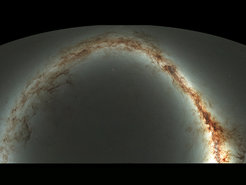Pan-STARRS releases catalogue of 3 billion astronomical sources

Pan-STARRS1 Observatory
In May 2010, the first Panoramic Survey Telescope & Rapid Response System or Pan-STARRS observatory, a 1.8-meter telescope at the summit of Haleakalā, on Maui, embarked on a digital map of the sky in visible and near infrared light. This was the first survey whose goal was to observe the sky very rapidly over and over again, looking for moving objects and transient or variable objects, including asteroids that could potentially threaten the Earth. The survey took approximately four years to complete, and scanned the sky 12 times in five filters.
The data comprise 3 billion separate sources, including stars, galaxies, and various other objects. The immense collection contains 2 petabytes of data, which is equivalent to 40 million four-drawer filing cabinets filled with single-spaced text. All this information had to be properly catalogued so that the astrophysics community can quickly access and exploit the data.

This compressed view of the entire sky visible from Hawai'i by the Pan-STARRS1 Observatory is the result of half a million exposures, each about 45 seconds in length, taken over a period of 4 years. The shape comes from making a map of the celestial sphere, like a map of the Earth, but leaving out the southern quarter. The disk of the Milky Way looks like a yellow arc, and the dust lanes show up as reddish brown filaments. The background is made up of billions of faint stars and galaxies. If printed at full resolution, the image would be 1.5 miles long, and you would have to get close and squint to see the detail.
“For the past three years, we put much effort into checking the quality of the data and defining the most useful structure for the catalogue,” explains Dr. Roberto Saglia, who led the Pan-STARRS participation at the Max Planck Institute for Extraterrestrial Physics. “In more than 100 teleconferences we discussed and improved test results, such as for astrometry or photometry for selected sky regions that have been observed previously with other telescopes. We also thought a lot about how best to combine the individual observations and how to present the relevant information for each type of objects.”
“Based on Pan-Starrs, researchers are able to measure distances, motions and special characteristics such as the multiplicity fraction of all nearby stars, brown dwarfs, and of stellar remnants like, for example white dwarfs. This will expand the census of almost all objects in the solar neighbourhood to distances of about 300 light-years”, says Thomas Henning, director of the Planet and Star Formation Department of MPIA. “The Pan Starrs data will also allow a much better characterization of low-mass star formation in stellar clusters. Furthermore, we gathered about 4 million stellar light curves to identify Jupiter-like planets in close orbits around cool dwarf stars in order to constrain the fraction of such extrasolar planetary systems.”
“We also monitored our nearest neighbour, the Andromeda galaxy, where we detected several microlensing events and many new Cepheids variables. This allowed us to better constrain compact dark matter in M31 and improve its distance accuracy,” concludes Ralf Bender, director of MPE.
But Pan-STARRS also reaches out to on astronomical objects beyond our cosmic neighbourhood.
“Pan-STARRS1 mapped our home galaxy, the Milky Way, to a level of detail never achieved before. The survey provides, for the first time, a deep and global view of a significant fraction of the Milky Way plane and disk—an area usually avoided by surveys given the complexity of mapping these dense and dusty regions”, explains Hans-Walter Rix, director of the Galaxies and Cosmology department of MPIA. “And Pan-STARRS1 goes far beyond that: its unique combination of imaging depth, area and colors allowed it to discover the majority of the most distant known quasars: these are the earliest examples in our universe that giant black holes had grown at the centers of galaxies”.
The roll-out of the data is being done in two steps. Today’s release is the “Static Sky,” which is the average of each of the individual epochs. For every object, there’s an average value for its position, its brightness, and its colours. Furthermore, for each object it will be possible to get the stack image in each of the observed colours. For galaxies there is further information such as their brightness for various aperture sizes and the seeing conditions. In 2017, the second set of data will be released, providing this information for each individual epoch, and also allowing people to access the individual images for each observation run. The full database will include information on each of the individual snapshots that Pan-STARRS took of a given region of sky, and that will complete the full 2 petabytes of data.
“Our next step then is to measure the redshifts - that means distances - of galaxies and other cosmological objects,” explains Saglia. “We need this information to analyse the distribution of galaxies in all three dimensions. From this structure, we can then infer the geometry of the Universe and further constrain our standard cosmological model. With the data of the individual epochs, we can then even study variability in far-away, active galaxies.” The redshift information will be added to the Pan-STARRS catalogue as well.
Note:
The Pan-STARRS1 Surveys have been made possible through contributions by the Institute for Astronomy, the University of Hawaii, the Pan-STARRS Project Office, the Max-Planck Society and its participating institutes, the Max Planck Institute for Astronomy, Heidelberg, and the Max Planck Institute for Extraterrestrial Physics, Garching, The Johns Hopkins University, Durham University, the University of Edinburgh, the Queen's University Belfast, the Harvard-Smithsonian Center for Astrophysics, the Las Cumbres Observatory Global Telescope Network Incorporated, the National Central University of Taiwan, the Space Telescope Science Institute, and the National Aeronautics and Space Administration under Grant No. NNX08AR22G issued through the Planetary Science Division of the NASA Science Mission Directorate, the National Science Foundation Grant No. AST-1238877, the University of Maryland, Eotvos Lorand University (ELTE), and the Los Alamos National Laboratory.













